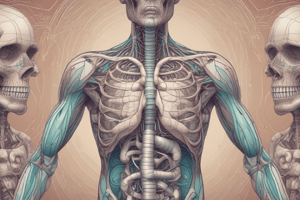Podcast
Questions and Answers
What is the primary function of the respiratory system?
What is the primary function of the respiratory system?
- To circulate blood throughout the body
- To digest food
- To bring oxygen into the body and remove carbon dioxide (correct)
- To filter waste from the blood
Which organ is responsible for conducting air to the bronchi?
Which organ is responsible for conducting air to the bronchi?
- Bronchi
- Nose and Mouth
- Trachea (Windpipe) (correct)
- Lungs
What is the primary muscle used for breathing?
What is the primary muscle used for breathing?
- Diaphragm (correct)
- Abdominal Muscles
- Pectoral Muscles
- Intercostal Muscles
What happens during exhalation?
What happens during exhalation?
What is the name of the brainstem region that regulates breathing?
What is the name of the brainstem region that regulates breathing?
What is the term for the air remaining in the lungs after exhalation?
What is the term for the air remaining in the lungs after exhalation?
Flashcards are hidden until you start studying
Study Notes
Overview
The respiratory system is a complex biological system that brings oxygen into the body and removes carbon dioxide.
Functions
- Gas Exchange: The respiratory system facilitates the exchange of oxygen and carbon dioxide between the atmosphere and the body's cells.
- Regulation of pH: The respiratory system helps maintain the body's acid-base balance by removing excess hydrogen ions.
Organs and Structures
- Nose and Mouth: Inhale air into the lungs.
- Trachea (Windpipe): Conducts air to the bronchi.
- Bronchi: Divide into smaller bronchioles, which lead to the lungs.
- Lungs: Responsible for gas exchange.
- Alveoli: Tiny sacs where gas exchange occurs.
- Diaphragm: Primary muscle used for breathing.
- Intercostal Muscles: Assist with breathing.
Breathing Process
- Inhalation:
- Diaphragm contracts, increasing thoracic cavity volume.
- Air enters the lungs through the nose or mouth.
- Exhalation:
- Diaphragm relaxes, decreasing thoracic cavity volume.
- Air is pushed out of the lungs.
Respiratory Cycle
- Inspiratory Reserve Volume: Additional air inhaled during deep breathing.
- Expiratory Reserve Volume: Additional air exhaled during forced exhalation.
- Residual Volume: Air remaining in the lungs after exhalation.
Control of Breathing
- Medulla Oblongata: Brainstem region that regulates breathing.
- Pons: Brainstem region that helps regulate breathing rate.
- Chemoreceptors: Sensors that detect changes in CO2 levels, influencing breathing rate.
Disorders and Diseases
- Asthma: Chronic inflammation and constriction of airways.
- Chronic Obstructive Pulmonary Disease (COPD): Progressive lung damage and airflow obstruction.
- Pneumonia: Infection of the lungs.
Overview of Respiratory System
- Brings oxygen into the body and removes carbon dioxide through gas exchange
Functions of Respiratory System
- Facilitates gas exchange between atmosphere and body's cells
- Regulates body's acid-base balance by removing excess hydrogen ions
Organs and Structures of Respiratory System
- Nose and mouth: inhale air into lungs
- Trachea (windpipe): conducts air to bronchi
- Bronchi: divide into smaller bronchioles, leading to lungs
- Lungs: responsible for gas exchange
- Alveoli: tiny sacs where gas exchange occurs
- Diaphragm: primary muscle used for breathing
- Intercostal muscles: assist with breathing
Breathing Process
- Inhalation:
- Diaphragm contracts, increasing thoracic cavity volume
- Air enters lungs through nose or mouth
- Exhalation:
- Diaphragm relaxes, decreasing thoracic cavity volume
- Air is pushed out of lungs
Respiratory Cycle
- Inspiratory Reserve Volume: additional air inhaled during deep breathing
- Expiratory Reserve Volume: additional air exhaled during forced exhalation
- Residual Volume: air remaining in lungs after exhalation
Control of Breathing
- Medulla oblongata: brainstem region that regulates breathing
- Pons: brainstem region that helps regulate breathing rate
- Chemoreceptors: sensors that detect changes in CO2 levels, influencing breathing rate
Disorders and Diseases of Respiratory System
- Asthma: chronic inflammation and constriction of airways
- Chronic Obstructive Pulmonary Disease (COPD): progressive lung damage and airflow obstruction
- Pneumonia: infection of the lungs
Studying That Suits You
Use AI to generate personalized quizzes and flashcards to suit your learning preferences.


